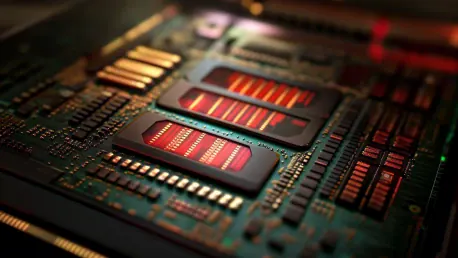In a significant move towards advancing network performance and security, Cisco has integrated AMD Pensando DPUs (Data Processing Units) into its latest Nexus 9300 smart switches. This development was unveiled at Cisco Live Amsterdam, where the company showcased the innovative features that promise to offload data-intensive tasks from traditional network infrastructure. By leveraging AMD’s Pensando DPUs, Cisco aims to centralize processing tasks within the switches themselves, thereby enhancing overall efficiency and reducing the need for costly individual DPU cards on connected systems.
Enhanced Network Capacity
Offloading Data Processing
One of the primary advantages of integrating AMD Pensando DPUs into Cisco’s Nexus 9300 smart switches is the ability to offload data processing tasks. Traditional DPUs like Nvidia’s BlueField or Marvell’s Octeon typically exist as add-in cards on individual systems, requiring significant investment and labor to manage. By incorporating Pensando DPUs directly into the network switches, Cisco reduces the load on individual systems by handling intensive data processing tasks within the switch infrastructure. This approach ensures more efficient use of resources, less wear and tear on individual systems, and improved network performance.
Additionally, the new Nexus 9300 switches feature Cisco’s in-house E100 ASIC from the Silicon One family, providing up to 4.8 Tbps of network capacity. This is a substantial leap in performance, capable of being divided across various configurations such as 24 x 100 Gbps ports or a top-of-rack (ToR) setup with 48 x 25 Gbps ports supplemented by several high-bandwidth ports. This versatility allows for greater flexibility in network design and deployment, catering to a range of customer needs while maintaining high-performance standards.
Integrated Security Capabilities
Security remains a top priority in network management, and the inclusion of Cisco’s Hypershield security platform in the Nexus 9300 switches underscores this commitment. Hypershield provides hyperscale distributed security across the switch portfolio, enabling robust protection against a myriad of cyber threats. The 24-port Nexus 9324C, which includes the older Elba generation of Pensando DPUs, and the larger 56-port ToR switch, featuring the power-efficient Giglio DPU, are both optimized for enhanced security without compromising performance. By integrating these DPUs directly into the switches, Cisco can deliver comprehensive security features that would traditionally require additional hardware or software solutions, thereby streamlining operations and reducing costs.
Programmable DPUs for Future Growth
AMD’s Strategic Collaborations
Before its acquisition by AMD in 2022, Pensando had already garnered attention through its collaboration with companies like HPE. These early partnerships laid the groundwork for the integration of programmable DPUs into mainstream networking equipment, a trend that continues to gain traction. The flexibility and programmability of Pensando’s P4-enabled DPUs enable a variety of services to be accelerated, from security to data processing, further enhancing their appeal in high-performance networking environments. By aligning with AMD, Cisco is poised to leverage this technology for scalable network solutions that can adapt to evolving demands.
Enhanced Efficiency and Security
Cisco has made a significant leap in enhancing network performance and security by integrating AMD Pensando Data Processing Units (DPUs) into its new Nexus 9300 smart switches. This milestone was announced at Cisco Live Amsterdam, where the company highlighted the advanced features designed to manage data-heavy tasks more effectively. Traditionally, network infrastructure relied on numerous individual DPU cards for processing. However, the inclusion of AMD’s Pensando DPUs allows Cisco to streamline these processes within the switches themselves. By centralizing the data processing tasks, Cisco not only boosts overall network efficiency but also reduces the necessity for expensive and numerous DPU cards on connected systems. This innovation aims to deliver a more cost-effective solution while significantly enhancing performance. Cisco’s focus on leveraging AMD technology underscores its commitment to pushing the boundaries of network infrastructure and ensuring that its products remain at the cutting edge of performance and security advancements.









